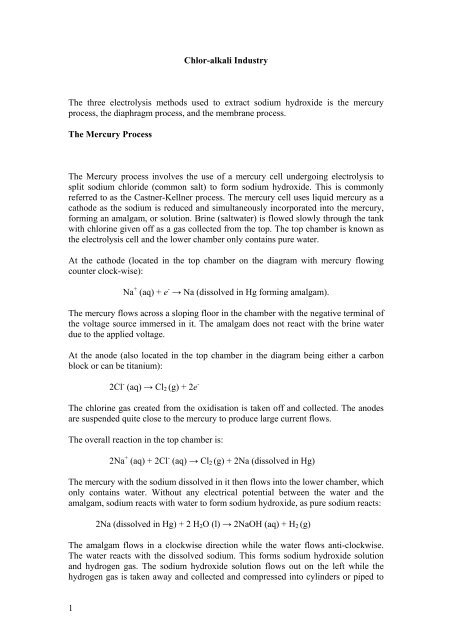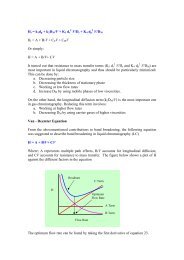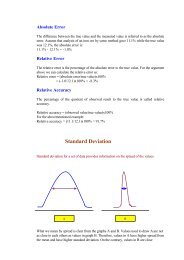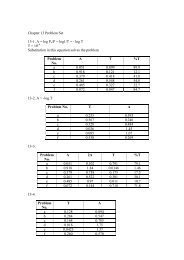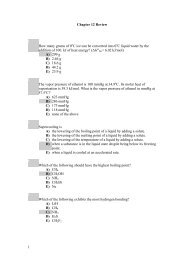Create successful ePaper yourself
Turn your PDF publications into a flip-book with our unique Google optimized e-Paper software.
<strong>Chlor</strong>-<strong>alkali</strong> <strong>Industry</strong><br />
The three electrolysis methods used to extract sodium hydroxide is the mercury<br />
process, the diaphragm process, and the membrane process.<br />
The Mercury Process<br />
The Mercury process involves the use of a mercury cell undergoing electrolysis to<br />
split sodium chloride (common salt) to form sodium hydroxide. This is commonly<br />
referred to as the Castner-Kellner process. The mercury cell uses liquid mercury as a<br />
cathode as the sodium is reduced and simultaneously incorporated into the mercury,<br />
forming an amalgam, or solution. Brine (saltwater) is flowed slowly through the tank<br />
with chlorine given off as a gas collected from the top. The top chamber is known as<br />
the electrolysis cell and the lower chamber only contains pure water.<br />
At the cathode (located in the top chamber on the diagram with mercury flowing<br />
counter clock-wise):<br />
Na + (aq) + e - → Na (dissolved in Hg forming amalgam).<br />
The mercury flows across a sloping floor in the chamber with the negative terminal of<br />
the voltage source immersed in it. The amalgam does not react with the brine water<br />
due to the applied voltage.<br />
At the anode (also located in the top chamber in the diagram being either a carbon<br />
block or can be titanium):<br />
2Cl - (aq) → Cl 2 (g) + 2e -<br />
The chlorine gas created from the oxidisation is taken off and collected. The anodes<br />
are suspended quite close to the mercury to produce large current flows.<br />
The overall reaction in the top chamber is:<br />
2Na + (aq) + 2Cl - (aq) → Cl 2 (g) + 2Na (dissolved in Hg)<br />
The mercury with the sodium dissolved in it then flows into the lower chamber, which<br />
only contains water. Without any electrical potential between the water and the<br />
amalgam, sodium reacts with water to form sodium hydroxide, as pure sodium reacts:<br />
2Na (dissolved in Hg) + 2 H 2 O (l) → 2NaOH (aq) + H 2 (g)<br />
The amalgam flows in a clockwise direction while the water flows anti-clockwise.<br />
The water reacts with the dissolved sodium. This forms sodium hydroxide solution<br />
and hydrogen gas. The sodium hydroxide solution flows out on the left while the<br />
hydrogen gas is taken away and collected and compressed into cylinders or piped to<br />
1
another factory. The sodium hydroxide is then drained off and replaced by water. By<br />
the time the sodium has reacted the mercury has left the tank so the mercury can be<br />
reused back in the electrolysis cell, or upper chamber.<br />
Mercury cells are generally one large cell (as shown in the diagram below) about 15<br />
m long and 1 m wide. It operates between 3 and 4 V which is a small amount<br />
compared to the amount of electricity used in factories. The solution is concentrated<br />
to about 50% and sold as such or evaporated to dryness to form a solid product. There<br />
is no contamination of the product with chloride due to pure water reacting with the<br />
mercury amalgam.<br />
The advantages of this process are that it produces very pure sodium and it avoids<br />
using asbestos. The disadvantage, however, is that mercury is lost to the environment<br />
sometimes as much as 100 to 200g per tonne of NaOH produced. Theoretically, the<br />
mercury should just be recycled indefinitely, as it is pumped back into the cell.<br />
However, there is an unavoidable mechanical transfer of mercury to the brine<br />
solution, which is discharged into the environment back to the ocean. Metallic<br />
mercury is extremely insoluble, so it would not pose a problem is it just remained at<br />
the bottom of the ocean. Despite this, there some bacteria that convert mercury into<br />
compounds such as dimethyl mercury, which can be taken up by organisms and<br />
passed along the food chain with the concentration amplified along the way. The<br />
result is consumers who eat fish can receive does of mercury which affects the<br />
nervous system, leading to brain damage. This has resulted in a limitation placed on<br />
the amount of mercury discharged with a limit of 1g per tonne of NaOH produced.<br />
This is difficult to meet so fewer mercury cells are being built.<br />
The Diaphragm process<br />
The diaphragm process used inert electrodes – a titanium electrode to withstand attack<br />
from the chlorine formed and an iron mesh cathode, which is not affected by the<br />
hydroxide solution.<br />
The chloride ions migrate to the anode and are oxidised to chlorine gas. Therefore the<br />
reaction at the anode is as follows:<br />
2Cl - (aq) → Cl 2 (g) + 2e -<br />
The sodium ions migrate to the cathode but they are too stable to be reduced: instead<br />
water is reduced to hydrogen gas and hydroxide ions and so a solution of sodium<br />
hydroxide is formed. Therefore at the cathode the reaction that takes place is:<br />
2 H 2 O (l) + 2e - → 2OH - + H 2 (g)<br />
The overall reaction of this, including the spectator ions is as follows:<br />
2Na + + 2Cl - + 2H 2 O → 2Na + + 2OH - + H 2 + Cl 2<br />
The complete ionic equation with neutral species is as follows:<br />
2
2NaCl (aq) + 2H 2 O (l) → 2NaOH (aq) + H 2 (g) + Cl 2 (g)<br />
The electrolysis produces chlorine and hydrogen gases and leaves behind a solution of<br />
sodium hydroxide. The process is producing both chlorine and sodium hydroxide.<br />
This is often referred to as chlor-<strong>alkali</strong> industry as both products are equally<br />
important. Hydrogen is also sold to other industries that need it (such as<br />
hydrogenation of oils for margarine etc). Practical problems that need to be addressed<br />
in the design of the cell include: keeping the gasses H 2 and Cl 2 separated as they react<br />
vigorously if in contact; minimising contact between hydroxide ion and chlorine in<br />
solution as OH - and Cl 2 forms unwanted chlorite, ClO - ; and minimising the amount of<br />
chloride present in the final hydroxide solution.<br />
The diagram below demonstrates the structure of a diaphragm cell. The diaphragm is<br />
a porous barrier between the anode and cathode compartments intended to allow<br />
sodium ion flow through to balance the charge of the hydroxide ion formed and<br />
complete the flow of electricity in the circuit also allowing a build up of sodium<br />
hydroxide in the cathode compartment. The diaphragm is made of asbestos, which is<br />
not damaged by the hydroxide solution. The gaseous chlorine in the anode<br />
compartment depletes the brine solution of chloride resulting in a slow flow of fresh<br />
brine into this compartment and removal of depleted brine. A barrier separates the H 2<br />
and Cl 2 gases so they can be used in other industries.<br />
The voltage across the electrodes is between 3.5 and 5 V. Each cell is quite small so<br />
that the gap between the electrodes and the diaphragm is small which will maximise<br />
current flow. Large number of cells are assembled together so that products are fed<br />
into the same collection areas and there only needs to be one take off point for each<br />
product and one input point for brine.<br />
The solution taken at the end has both sodium hydroxide and sodium chloride. Water<br />
is evaporated from this solution until the mass is 50% of sodium hydroxide. At this<br />
stage, most of the sodium chloride has crystallised so it can be filtered off and the<br />
solution of nearly pure sodium hydroxide can be sold or evaporated to dryness (like in<br />
the mercury cell) to produce solid sodium hydroxide. The product contains about 1 to<br />
2% sodium chloride.<br />
The advantages of this process is that large quantities of sodium hydroxide can be<br />
produced and chlorine, which are two high-demand industrial chemicals, at<br />
reasonable costs and at quite acceptable levels of purity. The disadvantages, however,<br />
is that: there is always a small amount of chloride in the NaOH produced there are<br />
health and environmental problems with small losses of asbestos in making and using<br />
diaphragms; there may be hypochlorite, a strong oxidant, in the waste brine solution<br />
and this needs to be removed before the brine is discharged into the environment.<br />
The Membrane Process<br />
A membrane cell is a diaphragm cell with an improved diaphragm called a<br />
‘membrane’. This is made from polytetrafluoroethylene (PTFE), making it a plastic<br />
membrane, which has been modified to include anionic groups to act as an ion<br />
exchange membrane. This allows sodium ions to pass through it but not chloride or<br />
hydroxide ions. PTFE is very inert and so can stand immersion in hydroxide solutions<br />
3
for long periods of time. Therefore, the same reactions occur as above in the<br />
diaphragm cell but there is no by-product of sodium chloride due to the membrane<br />
preventing the chloride and hydroxide ions to pass through.<br />
The use of this process results in virtually pure sodium hydroxide (only contains<br />
about 0.02% of sodium chloride at most) being produced as there is no contamination<br />
by chloride, and there is virtually no oxidant in the spent brine. Furthermore, there is<br />
no working hazard of working with asbestos or mercury.<br />
This process of using electrolysis to develop sodium hydroxide, has been adapted in<br />
all chlor-<strong>alkali</strong> plants due to its very pure production of sodium hydroxide, similar<br />
costs to that of the diaphragm cell (reasonable) and it has no negligible environmental<br />
impact. The advantages are much more preferable to that of the mercury and<br />
diaphragm process and the membrane process has negligible disadvantages proving to<br />
be the best technique for extracting sodium hydroxide<br />
<strong>Chlor</strong>/<strong>alkali</strong> manufacturing process<br />
Fig. 4. <strong>Chlor</strong>ine cell technology in the U.S.<br />
The chlor-<strong>alkali</strong> (also<br />
called "chlorinecaustic")<br />
industry is<br />
one of the largest<br />
electrochemical<br />
technologies in the<br />
world. It is an energy<br />
intensive process and<br />
is the second largest<br />
consumer of<br />
electricity (2400<br />
billion kWh) among<br />
electrolytic<br />
industries. In 2006,<br />
about 84% of the<br />
total world chlorine<br />
capacity of about 59<br />
million metric tons<br />
was produced<br />
electrolytically using<br />
diaphragm and<br />
membrane cells,<br />
while about 13% was<br />
made using mercury<br />
cells (Figure 4).<br />
<strong>Chlor</strong>ine is produced by the electrolysis of sodium chloride (common table salt)<br />
solution, often called "brine." Thus, when sodium chloride is dissolved in water, it<br />
dissociates into sodium cations and chloride anions. The chloride ions are oxidized at<br />
the anode to form chlorine gas and water molecules are reduced at the cathode to form<br />
hydroxyl anions and hydrogen gas. The sodium ions in the solution and the hydroxyl<br />
ions produced at the cathode constitute the components of sodium hydroxide formed<br />
4
during the electrolysis of sodium chloride. (The chemical reactions occurring in the<br />
cell are shown in the Appendix.)<br />
<strong>Chlor</strong>ine is produced electrolytically using three types of electrolytic cells. The main<br />
difference in these technologies lies in the manner by which the chlorine gas and the<br />
sodium hydroxide are prevented from mixing with each other to ensure generation of<br />
pure products. Thus, in diaphragm cells, brine from the anode compartment flows<br />
through the separator to the cathode compartment, the separator material being either<br />
asbestos or polymer-modified asbestos composite deposited on a foraminous cathode.<br />
In membrane cells, on the other hand, an ion-exchange membrane is used as a<br />
separator. Anolyte-catholyte separation is achieved in the diaphragm and membrane<br />
cells using separators and ion-exchange membranes, respectively, whereas mercury<br />
cells contain no diaphragm or membrane and the mercury itself acts as a separator.<br />
The anode in all technologies is titanium metal coated with an electrocatalytic layer of<br />
mixed oxides. All modern cells (since the 1970's) use these so-called “dimensionally<br />
stable anodes" (DSA). Earlier cells used carbon based anodes. The cathode is<br />
typically steel in diaphragm cells, nickel in membrane cells, and mercury in mercury<br />
cells. These cell technologies are schematically depicted in Figures 5-7 and are<br />
described below.<br />
Mercury cells<br />
Fig. 5. Schematic of a mercury cell.<br />
The current flows from the steel bottom to the flowing mercury.<br />
The mercury cell<br />
has steel bottoms<br />
with rubber-coated<br />
steel sides, as well<br />
as end boxes for<br />
brine and mercury<br />
feed and exit<br />
streams with a<br />
flexible rubber or<br />
rubber-coated steel<br />
cover. Adjustable<br />
metal anodes hang<br />
from the top, and<br />
mercury (which<br />
forms the cathode of<br />
the cell) flows on<br />
the inclined bottom.<br />
Saturated brine fed from the end box is electrolyzed at the anode to produce the<br />
chlorine gas, which flows from the top portion of the trough and then exits. The<br />
sodium ion generated reacts with the mercury to form sodium amalgam (an alloy of<br />
mercury and sodium), which flows out of the end box to a vertical cylindrical tank.<br />
About 0.25% to 0.5% sodium amalgam is produced in the cell. The sodium amalgam<br />
reacts with water in the decomposer, packed with graphite particles and produces<br />
caustic soda and hydrogen. Hydrogen, saturated with water vapor, exits from the top<br />
along with the mercury vapors. The caustic soda then flows out of the decomposer as<br />
50% caustic. The unreacted brine flows out of the exit end box. Some cells are<br />
5
designed with chlorine and anolyte outlets from the end box, which are separated in<br />
the depleted brine tank. The mercury from the decomposer is pumped back to the cell.<br />
Diaphragm cells<br />
The diaphragm cell<br />
is a rectangular box<br />
with metal anodes<br />
supported from the<br />
bottom with copperbase<br />
plates, which<br />
carries a positive<br />
current. The cathodes<br />
are metal screens or<br />
punch plates<br />
connected from one<br />
end to the other end<br />
of the rectangular<br />
tank. Asbestos,<br />
Fig. 6. Schematic of a diaphragm cell.<br />
dispersed as a slurry<br />
in a bath, is vacuum<br />
deposited onto the cathodes, forming a diaphragm. Saturated brine enters the anode<br />
compartment and the chlorine gas liberated at the anode during electrolysis, exits<br />
from the anode compartment. It is saturated with water vapor at a partial pressure of<br />
water over the anolyte. The sodium ions are transported from the anode compartment<br />
to the cathode compartment, by the flow of the solution and by electromigration,<br />
where they combine with the hydroxyl ions generated at the cathode during the<br />
formation of the hydrogen from the water molecules. The diaphragm resists the back<br />
migration of the hydroxyl ions, which would otherwise react with the chlorine in the<br />
anode compartment. In the cathode compartment, the concentration of the sodium<br />
hydroxide is ~12%, and the salt concentration is ~14%. There is also some sodium<br />
chlorate formed in the anode compartment, dependent upon the pH of the anolyte.<br />
Membrane cells<br />
Fig. 7. Schematic of a membrane cell.<br />
In a membrane cell,<br />
an ion-exchange<br />
membrane separates<br />
the anode and<br />
cathode<br />
compartments. The<br />
separator is<br />
generally a bi-layer<br />
membrane made of<br />
perfluorocarboxylic<br />
and<br />
perfluorosulfonic<br />
acid-based films,<br />
sandwiched between<br />
the anode and the<br />
cathode. The<br />
6
saturated brine is fed to the anode compartment where chlorine is liberated at the<br />
anode, and the sodium ion migrates to the cathode compartment. Unlike in the<br />
diaphragm cells, only the sodium ions and some water migrate through the membrane.<br />
The unreacted sodium chloride and other inert ions remain in the anolyte. About 30-<br />
32% caustic soda is fed to the cathode compartment, where sodium ions react with<br />
hydroxyl ions produced during the course of the hydrogen gas evolution from the<br />
water molecules. This forms caustic, which increases the concentration of caustic<br />
solution to ~35%. The hydrogen gas, saturated with water, exits from the catholyte<br />
compartment. Only part of the caustic soda product is withdrawn from the cathode<br />
compartment. The remaining caustic is diluted to ~32% and returned to the cathode<br />
compartment.<br />
Thus, all three basic cell technologies generate chlorine at the anode, and hydrogen<br />
along with sodium hydroxide (caustic soda) in the cathode compartment (or in a<br />
separate reactor for mercury cells, see Figure 5). The distinguishing difference<br />
between the technologies lies in the manner by which the anolyte and the catholyte<br />
streams are prevented from mixing with each other. Separation is achieved in a<br />
diaphragm cell by a separator, and in a membrane cell by an ion-exchange membrane.<br />
In mercury cells, the cathode itself acts as a separator by forming an alloy of sodium<br />
and mercury (sodium amalgam) which is subsequently reacted with water to form<br />
sodium hydroxide and hydrogen in a separate reactor.<br />
A comparison of the performance characteristics of these three technologies is<br />
presented in the Appendix together with schematic process diagram for each of the<br />
cell technologies. The primary technology that is presently being used for future<br />
expansions or replacements of existing circuits is the membrane cell technology. The<br />
major membrane cell technology suppliers, include: Uhde GmbH, Asahi Chemicals,<br />
and <strong>Chlor</strong>ine Engineers. DeNora Tech is the sole supplier of diaphragm cell<br />
technology. It is highly unlikely that anyone will build a new mercury- or diaphragmcell<br />
plant in the future. Figures 8 and 9 illustrate cell rooms with diaphragm and<br />
membrane chlor-<strong>alkali</strong> cells.<br />
Fig. 8. <strong>Chlor</strong>-<strong>alkali</strong> cell room with MDC-55 diaphragm cells<br />
(Courtesy of Occidental Chemical Corporation).<br />
7
Fig. 9. <strong>Chlor</strong>-<strong>alkali</strong> cell room with BL-2.7 membrane cells<br />
(Courtesy of Uhde GmbH).<br />
<strong>Chlor</strong>ine processing<br />
The chlorine gas from the anode compartment contains moisture, by-product oxygen,<br />
and some back-migrated hydrogen. In addition, if the brine is <strong>alkali</strong>ne, it will contain<br />
carbon dioxide and some oxygen and nitrogen from the air leakage via the process or<br />
pipelines.<br />
<strong>Chlor</strong>ine is first cooled to 60 o F (16 o C) and passed through demisters to remove the<br />
water droplets and the particulates of salt and sodium sulfate. The cooled gas goes to<br />
sulfuric acid circulating towers, which are operated in series. Commonly, three towers<br />
are used for the removal of moisture. The dried chlorine then goes through demisters<br />
before it is compressed and liquefied at low temperatures. The non-condensed gas,<br />
called snift gas, is used for producing hypochlorite or hydrochloric acid. If there is no<br />
market for hydrochloric acid, the snift gas is neutralized with caustic soda or lime<br />
(calcium hydroxide) to form hypochlorite. The hypochlorite is either sold as bleach or<br />
decomposed to form salt and oxygen.<br />
Brine processing<br />
Sodium chloride is available in the form of solid salt, mined by excavation or by<br />
evaporating seawater. It is also available as a liquid by solution mining the salt domes.<br />
The salt has varying concentrations of impurities, which should be removed to operate<br />
the electrolytic cells at a high current efficiency. The major impurities are calcium,<br />
magnesium, and sulfates. The other minor impurities, which are undesirable,<br />
depending upon the type of chlor-<strong>alkali</strong> process selected, are barium, strontium,<br />
manganese, aluminum, silica, iron, vanadium, chromium, molybdenum, titanium, etc.<br />
The solution-mined brine or the solid salt dissolved in the salt dissolver is treated in a<br />
reactor with sodium carbonate and caustic soda to precipitate calcium carbonate and<br />
magnesium hydroxide (see the Appendix). These precipitates are settled in a settler.<br />
The underflow carries the solid slurry, which is pumped to a filter to remove it as<br />
8
sludge, or sometimes, it is disposed off along with the rest of the liquid effluent from<br />
the plant. The calcium carbonate precipitates are heavy, and drag with it the<br />
hydroxides of aluminum, magnesium, strontium, etc. The overflow from the settler,<br />
which carries ~10-50 ppm (parts per million) of suspended solids, is filtered. For the<br />
mercury and the diaphragm cell process, this brine is adequate, and can be fed to the<br />
electrolyzers.<br />
In the all cell processes, the filtered brine is heated and passed through a bed of salt in<br />
a saturator in order to increase the salt concentration before feeding it to the<br />
electrolyzers. In some plants, the brine feed is acidified to improve the cell current<br />
efficiency. The acidification reduces the <strong>alkali</strong>nity, which would otherwise react with<br />
the chlorine in the anolyte compartment forming chlorate.<br />
The membrane cell process brine specifications are more stringent than that of the<br />
mercury and diaphragm processes, and calls for impurities to be at the parts-perbillion<br />
(ppb) level. This is accomplished by filtering the brine in a pre-coat type<br />
secondary filter. An ion-exchange resin is used to remove the calcium, magnesium,<br />
barium, and iron impurities. It is also possible to remove aluminum by ion exchange.<br />
Often, aluminum and silica are removed by adding magnesium chloride in the brine<br />
exiting from the salt dissolver.<br />
The depleted brine from the membrane and mercury cell processes carries dissolved<br />
chlorine. This brine is acidified to reduce the chlorine solubility, and then<br />
dechlorinated in a vacuum brine dechlorinator. The dechlorinated brine is returned to<br />
the brine wells for solution mining or to the salt dissolver. If the membrane and<br />
diaphragm processes coexist at a given location, the dechlorinated brine can be sent to<br />
a saturator for resaturation before being sent to the diaphragm cells.<br />
Sodium hypochlorite manufacturing process<br />
Another useful product generated by the electrolysis of weak brine is sodium<br />
hypochlorite, otherwise known as "bleach." Sodium hypochlorite cells generally do<br />
not require saturated brine, but can utilize weak brine or even seawater. Bleach is<br />
produced "on-site" for disinfection of drinking water and wastewater. The cells<br />
employed for this purpose are the same as those used for chlorate manufacture, that is,<br />
they consist of an anode and a cathode without a separator or diaphragm. The anodic<br />
and the cathodic reactions are the same as in chlor-<strong>alkali</strong> and chlorate cells, the<br />
difference being the pH of the electrolyte, which is maintained in the range of 10 to<br />
12. The electrolytically generated chlorine reacts with sodium hydroxide to form<br />
sodium hypochlorite. However, the hypochlorite ion, formed in the bulk, is easily<br />
reduced at the cathode to reform chloride. Therefore, only dilute solutions of bleach<br />
can be produced in the cell. Hypochlorite can also react further to form chlorate, but<br />
this can be minimized by keeping the solution basic and the temperature low (close to<br />
room temperature).<br />
There are several manufacturers of seawater electrolysis cells in the market. The best<br />
known cells include Seachlor made by DeNora (producing 1000-2500 ppm active<br />
chlorine) or Salinec made by Exceltec International Corporation (generating 200-300<br />
ppm active chlorine).<br />
9
Appendix<br />
<strong>Chlor</strong>/<strong>alkali</strong> manufacturing process<br />
cells<br />
Electrochemical and chemical reactions occurring in mercury<br />
[1] 2Cl - ==> Cl 2 + 2e - (anodic reaction)<br />
[2] 2Na + + 2Hg + 2e - ==> 2Na (in Hg) (cathodic reaction)<br />
[3] 2Cl - + 2Na + + 2Hg ==> Cl 2 + 2Na (in Hg) (overall cell reaction)<br />
[4] 2Na (in Hg) + 2H 2 O ==> H 2 +2NaOH + Hg (decomposer reaction)<br />
[5] 2NaCl + 2H 2 O ==> Cl 2 +2NaOH + H 2 (overall process reaction)<br />
Electrochemical and chemical reactions occurring in<br />
diaphragm and membrane cells<br />
[1] 2Cl - ==> Cl 2 + 2e - (anodic reaction)<br />
[6] 2H 2 O + 2e - ==> 2OH - + H 2 (cathodic reaction)<br />
[7] 2Cl - + 2H 2 O ==> Cl 2 + H 2 + 2OH - (overall ionic reaction)<br />
[5] 2NaCl + 2H 2 O ==> Cl 2 +2NaOH + H 2 (overall reaction)<br />
[8] Cl 2 + 2NaOH ==> NaOCl + NaCl + H 2 O (side reaction)<br />
[9] 3NaOCl ==> NaClO 3 + 2NaCl (side reaction)<br />
Reaction [9] will contaminate the caustic product with chlorate.<br />
Chemical reactions occurring in brine processing<br />
[10] CaSO 4 + Na 2 CO 3 ==> CaCO 3 +NaSO 4 (CaCO 3 precipitates)<br />
[11] MgCl 2 + 2NaOH ==> Mg(OH) 2 + 2NaCl (Mg(OH) 2 precipitates)<br />
Comparison of cell technologies<br />
Mercury Diaphragm Membrane<br />
Operating current density ( kA/m 2 ) 8 - 13 0.9 - 2.6 3 - 5<br />
Cell voltage (V) 3.9 - 4.2 2.9 - 3.5 3.0 - 3.6<br />
NaOH strength (wt%) 50 12 33-35<br />
Energy consumption ( kWh/MT Cl 2 ) at a 3360 (10) 2720 (1.7) 2650 (5)<br />
10
current density of (kA/m 2 )<br />
Steam consumption (kWh/MT Cl 2 ) for<br />
concentration to 50% NaOH<br />
0 610 180<br />
Process flow sheets<br />
Fig. 12. Mercury cell process flow sheet.<br />
11
Fig. 13. Diaphragm cell process flow sheet.<br />
12
Fig. 14. Membrane cell process flow sheet.<br />
13
Sodium hypochlorite/chlorate manufacturing process<br />
Electrochemical and chemical reactions occurring in cells<br />
[1] 2Cl - ==> Cl 2 + 2e - (anodic reaction)<br />
[7] 2H 2 O + 2e - ==> 2OH - + H 2 (cathodic reaction)<br />
[8] Cl 2 + 2OH - ==> OCl - + Cl - + H 2 O (hypochlorite formation)<br />
[9] 3OCl - ==> ClO - 3 + 2Cl - (chlorate formation)<br />
[12] NaCl + H 2 O ==> NaOCl + H 2<br />
(overall<br />
reaction)<br />
hypochlorite<br />
[13] NaCl + 3H 2 O ==> NaClO 3 + 3H 2 (overall chlorate reaction)<br />
[14] 3Cl 2 + 6NaOH ==> NaClO 3 + 5NaCl + 3H 2 O<br />
(chemical<br />
formation)<br />
chlorate<br />
Hypochlorite formation is promoted by the use of weak brine, basic solution, and low<br />
cell temperatures.<br />
<strong>Chlor</strong>ate formation is promoted by the use of saturated brine, acidic solution, and<br />
temperatures close to the boiling point of the solution.<br />
14


